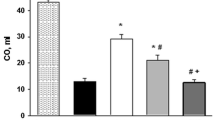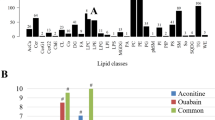Abstract
Increased plasma creatine kinase-myoglobin (CK-MB) occurs in patients with acute myocardial infarction (AMI), but its underlying relationship with cytosolic phospholipase A2 (cPLA2) is poorly understood. In the present study we sought to determine cPLA2 activation and its relationship with plasma and myocardial CK-MB level and membrane phospholipids (PLs) in an animal model of AMI. AMI was induced in 60 male Sprague-Dawley rats by ligating the left anterior descending of coronary artery. Rats were randomized into six groups at 0 (sham group), 1, 2, 4, 6, and 12 h after AMI onset (ten rats in each group). cPLA2 was detected by reverse transcription polymerase chain reaction and immunohistochemical staining for mRNA and protein expression, respectively. Plasma and myocardial CK-MB activity were measured by inhibition kinetics, and membrane PLs were determined by phosphorus quantitative method. Myocardial cPLA2 expression increased from 1 h and reached a peak at 2 h after AMI onset (p < 0.01) followed by a decrease but still remained high, whereas plasma CK-MB significantly increased in rats from 4 h after the onset of AMI (p < 0.05). During the first 6 h of AMI, a negative correlation existed between myocardial cPLA2 and membrane PLs (r = −0.504, p < 0.01), whereas myocardial cPLA2 levels were positively associated with plasma CK-MB (r = 0.741, p < 0.01) but negatively correlated with myocardial CK-MB in AMI groups (r = −0.785, p < 0.01). Myocardial cPLA2 level increased and is positively correlated with plasma CK-MB activity and negatively correlated with membrane phospholipid content in AMI rats at early stage.




Similar content being viewed by others
References
Li WH, Sun CQ, Xie Q, Wu R, Lin KM (2009) Simvastatin inhibits sPLA2 IIa expression in aorta and myocardium. Arch Med Res 40:67–72
Zhang JP, Liang WY, Luo ZH, Yang ZC, Chan HC, Huang YS (2007) Involvement of p38 MAP kinase in burn-induced degradation of membrane phospholipids and upregulation of cPLA2 in cardiac myocytes. Shock 28:86–93
Engelbrecht AM, Ellis B (2007) Apoptosis is mediated by cytosolic phospholipase A2 during simulated ischaemia/reperfusion-induced injury in neonatal cardiac myocytes. Prostaglandins Leukot Essent Fatty Acids 77:37–43
De Windt LJ, Reneman RS, Van der Vusse GJ, Van Bilsen M (1998) Phospholipase A2 mediated hydrolysis of cardiac phospholipids: the use of molecular and transgenic techniques. Mol Cell Biochem 180:65–73
Oka H, Ikeda S, Koga S, Miyahara Y, Kohno S (2008) Atorvastatin induces associated reductions in platelet P-selectin, oxidized low-density lipoprotein, and interleukin-6 in patients with coronary artery diseases. Heart Vessels 23(4):249–256
Tan J, Hua Q, Li J, Fan Z (2009) Prognostic value of interleukin-6 during a 3-year follow-up in patients with acute ST-segment elevation myocardial infarction. Heart Vessels 24(5):329–334
Hansson GK (2005) Inflammation, atherosclerosis, and coronary artery diseases. N Engl J Med 352:1685–1695
Evans JH, Spencer DM, Zweifach A, Leslie CC (2001) Intracellular calcium signals regulating cytosolic phospholipase A2 translocation to internal membranes. J Biol Chem 276:30150–30160
Hasegawa S, Kohro Y, Tsuda M, Inoue K (2009) Activation of cytosolic phospholipase A2 in dorsal root ganglion neurons by Ca2+/calmodulin-dependent protein kinase II after peripheral nerve injury. Mol Pain 5:22
Gijón MA, Leslie CC (1999) Regulation of arachidonic acid release and cytosolic phospholipase A2 activation. J Leukoc Biol 65:330–336
Sharp JD, White DL (1993) Cytosolic phospholipase A2 mRNA levels and potential for transcriptional regulation. J Lipid Mediat 8:183–189
Jiang YJ, Lu B, Choy PC, Hatch GM (2003) Regulation of cytosolic phospholipase A2, cyclooxygenase-1 and -2 expression by PMA, TNFalpha, LPS and M-CSF in human monocytes and macrophages. Mol Cell Biochem 246:31–38
Millanvoye-Van Brussel E, David-Dufilho M, Pham TD, Iouzalen L, Aude Devynck M (1999) Regulation of arachidonic acid release by calcium influx in human endothelial cells. J Vasc Res 36:235–244
Maclouf J, Folco G, Patrono C (1998) Eicosanoids and iso-eicosanoids: constitutive, inducible and transcellular biosynthesis in vascular disease. Thromb Haemost 79:691–705
Hao-zhu C (2007) Practical cardiology, 4th edn (in Chinese). Shanghai Science and Technology Publishing House, Shanghai, pp 871–888
Cao Y, Pearman AT, Zimmerman GA, McIntyre TM, Prescott SM (2000) Intracellular unesterified arachidonic acid signals apoptosis. Proc Natl Acad Sci USA 97:11280–11285
Chan TA, Morin PJ, Vogelstein B, Kinzler KW (1998) Mechanisms underlying nonsteroidal anti-inflammatory drug-mediated apoptosis. Proc Natl Acad Sci USA 95:681–686
Björkerud S, Björkerud B (1996) Apoptosis is abundant in human atherosclerotic lesions, especially in inflammatory cells (macrophages and T cells), and may contribute to the accumulation of gruel and plaque instability. Am J Pathol 149:367–380
Kolodgie FD, Narula J, Haider N, Virmani R (2001) Apoptosis in atherosclerosis: does it contribute to plaque instability? Cardiol Clin 19:127–139 ix
Sapirstein A, Bonventre JV (2000) Phospholipases A2 in ischemic and toxic brain injury. Neurochem Res 25:745–753
Landis RC, Asimakopoulos G, Poullis M, Haskard DO, Taylor KM (2001) The antithrombotic and antiinflammatory mechanisms of action of aprotinin. Ann Thorac Surg 72:2169–2175
Ye Y, Lin Y, Manickavasagam S, Perez-Polo JR, Tieu BC, Birnbaum Y (2008) Pioglitazone protects the myocardium against ischemia-reperfusion injury in eNOS and iNOS knockout mice. Am J Physiol Heart Circ Physiol 295(6):H2436–H2446
Acknowledgments
This study was supported by a grant from the Critical Disease Research Project, Xiamen, China (#3502Z20074001/#XMWZK0603). We thank Sharon Morey for review of the manuscript.
Author information
Authors and Affiliations
Corresponding author
Rights and permissions
About this article
Cite this article
Wei-hua, L., Jun-yu, H., Chang-qing, S. et al. Study on the relationship of cPLA2, CK-MB, and membrane phospholipid content in acute myocardial infarction. Heart Vessels 26, 64–68 (2011). https://doi.org/10.1007/s00380-010-0031-2
Received:
Accepted:
Published:
Issue Date:
DOI: https://doi.org/10.1007/s00380-010-0031-2




